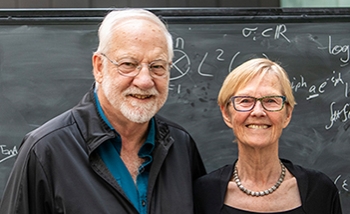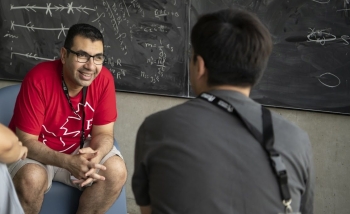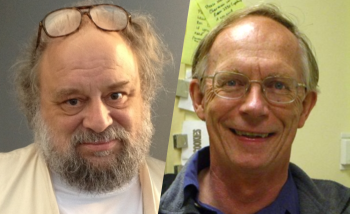Given annually to a graduate student (or, in this case, a pair of students) working under the supervision of a researcher at Perimeter, the award is named in honour of one of Perimeter’s first postdoctoral researchers. Caetano and Toledo won it for their paper, “χ Systems for Correlation Functions.”
Caetano and Toledo are supervised by Perimeter Faculty member Pedro Vieira. “The Brodie Prize is meant to reward brilliance, but also independence, and this work is a perfect example that combines both,” Vieira says. “Jon and João’s paper is an important paper in the field. It would be a significant paper for someone at any stage of their career, but it’s particularly impressive as a paper written by students – as a first paper written without supervision.”
The work which won Caetano and Toledo the prize started when the pair attended the “Integrability in Gauge and String Theory” conference at Perimeter last year. They saw a talk on correlation functions for three operators in strongly-coupled quantum field theories, and decided to extend it to correlation functions for four operators.
A bit of background: Quantum field theory is a framework for understanding physical particles and their interactions by modelling those particles in terms of an underlying field – rather like understanding the movement of the knots in a fishing net by understanding the net itself. It’s a highly successful system that underpins most of modern physics.
Caetano and Toledo are specifically interested in a quantum field theory called N=4 supersymmetric Yang-Mills, which is interesting to physicists because one can in principle solve it exactly. Correlation functions are one of the most interesting things to study within this theory because if you can solve all the correlation functions, you in principle know all the physical information about the theory. Caetano and Toledo were trying to extend a system for understanding the correlations between three operators into a system for understanding the correlations between four operators. They ended up with a system that should work for any number of operators.
Toledo and Caetano at first thought their project would be easy – so easy that Toledo thought they might solve it in one day. “On the face of it,” says Caetano, “there was no reason that the same kind of techniques that worked for three points shouldn’t work for four.” But they didn’t.
Their supervisor, Vieira, also thought it might be easy. “When they started, I told them this could be solved trivially, using the same kind of techniques we often use – namely, I thought we could just hit the problem with determinant identities until the problem was dead. I was wrong.”
“It was necessary to find a more powerful mathematical technology to solve this problem,” Vieira continues. “Namely, João and Jon had to delve into some very advanced papers, such as one from Davide [Perimeter Faculty member Davide Gaiotto] on wall-crossings. They studied these works, and managed to learn this technology, to review it, to simplify it, and to apply it very successfully.”
“Yes, there turned out to be a big difference between three points and four points,” says Toledo. “The good news is that now that it’s done, it should work for any number of points.”
“This result is just a beginning,” says Vieira. “As you stare at this result, it is so beautiful, and its physics are begging to be interpreted and understood, to be explored further. I think this result is like an island from which these students can explore, and I am sure that they will do that very successfully.”
ABOUT THE JOHN BRODIE MEMORIAL PRIZE
This award honours John Brodie, one of Perimeter’s first postdoctoral researchers. Brodie joined the fledgling Perimeter Institute in 2001, having obtained his doctorate in theoretical physics from Princeton University and done postdoctoral work at the Stanford Linear Accelerator Center. During his short career, he published 15 research papers, many of which have proven to be quite influential. His work was notable for its breadth, ranging from nonperturbative effects in supersymmetric gauge theories to string theoretic descriptions of quantum Hall fluids and of inflationary cosmology. Brodie, tragically, died in 2006. He was just 36 years old.
About PI
Perimeter Institute is the world’s largest research hub devoted to theoretical physics. The independent Institute was founded in 1999 to foster breakthroughs in the fundamental understanding of our universe, from the smallest particles to the entire cosmos. Research at Perimeter is motivated by the understanding that fundamental science advances human knowledge and catalyzes innovation, and that today’s theoretical physics is tomorrow’s technology. Located in the Region of Waterloo, the not-for-profit Institute is a unique public-private endeavour, including the Governments of Ontario and Canada, that enables cutting-edge research, trains the next generation of scientific pioneers, and shares the power of physics through award-winning educational outreach and public engagement.
You might be interested in


Perimeter Hosts Strings 2023: Spotlighting new directions and uniting a community
September 22, 2023

